Influence of TiN Coating on the Drawing Force and Friction Coefficient in the Deep Drawing Process of AlMg4.5Mn0.7 Thin Sheets
Abstract
:1. Introduction
2. Literature Review
3. Materials and Methods
3.1. The Experimental Apparatus and Setup
3.2. Previously Defined Pressure Dependencies
4. Results and Discussion
5. Conclusions
- (a)
- In the case of pressure changes that begin with a decreasing trend (P1 and P4 up to half of the stroke, Figure 5a,b), higher values of traction forces and friction coefficients are noticeable, with respect to changes in P2 and, in part, P3. High values of contact pressure at the beginning of the stroke adversely affect the retaining of the lubricant in contact. Applying the functional change P2 (Figure 5a) results in significantly lower values of traction forces and friction coefficients (Figure 6b, Figure 8b, Figure 10b and Figure 12b), which makes the sliding process significantly easier. With this change, the pressure values at the beginning of the stroke are small and gradually increase to the maximum, which keeps the lubricant in the contact zone longer for the duration of the pulling stroke;
- (b)
- The problem appears to be determining the real values of the friction coefficients for pressure changes that end in a downward trend: P1 and P3 (Figure 11a, Figure 12a and Figure 13a). In these cases, it is possible to control the friction until the moment when the pressure drops so much that the contact between the sheet and the sliding elements becomes questionable. These are the values close to zero. On the diagrams, this moment is manifested by a sharp jump in the coefficient of friction;
- (c)
- The change in P3 (Figure 5b) ends with an intensely decreasing trend (from the middle to the end of the stroke). Thus, considering the tendency of the pressure towards zero, unrealistic values for the friction coefficient were obtained; see expression (1). These are the values on the diagram that have a jumpy trend (Figure 11a). Discarding the pressure values for the part of the stroke from 45 to 55 mm (Figure 11a), the average values of the coefficient of friction, according to the type of surface, are: 0.13—nitrided surfaces, 0.105—TiN coating, 0.09—ground surfaces and 0.075—polished surfaces, which correlates with the diagrams of drawing forces under the same conditions (Figure 7a);
- (d)
- Contact surfaces of different roughness values, in combination with oil or lubricating grease, have different effects on the drawing force and friction coefficient. This is largely influenced by the character of the functional pressure variation. It is more suitable to use surfaces of lesser roughness (ground and polished) in combination with oil, while lubricating grease is recommended in combination with surfaces of higher roughness (nitrided surfaces and TiN coatings, Table 1);
- (e)
- The tendency of surfaces of a lesser roughness (mostly polished) towards formation of glued Al sheet layers was observed in the contact zone. This phenomenon is particularly prominent when lubricating was performed with grease based on MoS2, especially in conditions of high contact pressures at the beginning of the stroke of the decreasing pressure changes P1 and P4 (Figure 8b and Figure 9b). The reason for this is that the lubricant is then partially pushed out of the contact zone. On the other hand, the nitrided surfaces and titanium nitride coatings had a better ability to retain MoS2-based lubricant in the surface roughness depressions (Figure 12a and Figure 13b). A lower affinity of the polished and ground surfaces towards the formation of glued patches was present when lubrication was performed with oil (Figure 10a and Figure 11b);
- (f)
- Titanium nitride coatings, which are mainly used in metal cutting, are suitable for use in sheet metal forming by deep drawing in combination with lubricating greases based on MoS2 under all pressure change conditions (Figure 8, Figure 9, Figure 12 and Figure 13) due to their better ability to retain lubricant in surface roughness depressions, even at higher pressures;
- (g)
- Better retention of the lubricating grease in surface roughness depressions was observed with the TiN coating, which makes the lubricating layer sustainable, even at higher contact pressure values. In such conditions, the formation of glued layers of sheet metal on replaceable sliding elements is minimal;
- (h)
- The stability of the TiN coatings of the sliding elements was not affected, even after a significant amount of testing as well as the periodic removal of glued Al alloy sheet layers from the contact surfaces of the coating.
Author Contributions
Funding
Institutional Review Board Statement
Informed Consent Statement
Data Availability Statement
Conflicts of Interest
References
- Fratini, L.; Casto, S.L.; Valvo, E.L. A technical note on an experimental device to measure friction coefficient in sheet metal forming. J. Mater. Process. Technol. 2006, 172, 16–21. [Google Scholar] [CrossRef]
- Szakaly, E.D.; Lenard, J.G. The effect of process and material parameters on the coefficient of friction in the flat-die test. J. Mater. Process. Technol. 2010, 210, 868–876. [Google Scholar] [CrossRef]
- Figueiredo, L.; Ramalho, A.; Oliveira, M.C.; Menezes, L.F. Experimental study of friction in sheet metal forming. Wear 2011, 271, 1651–1657. [Google Scholar] [CrossRef]
- Coello, J.; Miguel, V.; Martinez, A.; Avellaneda, F.J.; Calatayud, A. Friction behavior evaluation of an EBT zinc-coated trip 700 steel sheet through flat friction tests. Wear 2013, 305, 129–139. [Google Scholar] [CrossRef]
- Yanagida, A.; Azushima, A. Evaluation of coefficients of friction in hot stamping by hot flat drawing test. CIRP Ann. Manuf. Technol. 2009, 58, 247–250. [Google Scholar] [CrossRef]
- Manoylov, A.V.; Bryant, M.J.; Evans, H.P. Dry elasto-plastic contact of nominally flat surfaces. Tribol. Int. 2013, 65, 248–258. [Google Scholar] [CrossRef]
- Kondratiuk, J.; Kuhn, P. Tribological investigation on friction and wear behavior of coatings for hot sheet metal forming. Wear 2011, 270, 839–849. [Google Scholar] [CrossRef]
- Ghiotti, A.; Brusch, S. Tribological behavior of DLC coatings for sheet metal forming tools. Wear 2010, 271, 2454–2458. [Google Scholar] [CrossRef]
- Lee, B.H.; Keum, Y.T.; Wagoner, R.H. Modelling of the friction caused by lubrication and surface roughness in sheet metal forming. J. Mater. Process. Technol. 2002, 130–131, 60–63. [Google Scholar] [CrossRef]
- Kirkhorn, L.; Bushlya, V.; Andersson, M.; Stahl, J.E. The influence of tool steel microstructure on friction in sheet metal forming. Wear 2013, 302, 1268–1278. [Google Scholar] [CrossRef]
- Aleksandrović, S.; Stefanović, M.; Adamović, D.; Lazić, V.; Babić, M.; Nikolić, R.; Vujinović, T. Variable tribological conditions on the flange and nonmonotonous forming in deep drawing of coated sheets. J. Balk. Tribol. Assoc. 2011, 17, 165–178. [Google Scholar]
- Kosanov, J.; Lenard, J.G.; Uhrig, J.; Wallfarth, B. The effect of lubricant additives on the coefficient of friction in the flat-die test. Mater. Sci. Eng. A 2006, 427, 274–281. [Google Scholar] [CrossRef]
- Sheu, S.; Hector, L.G.; Richmond, O. Tool surface topographies for controlling friction and wear in metal forming processes. J. Tribol. Trans. ASME 1998, 120, 517–527. [Google Scholar] [CrossRef]
- Novotný, J.; Hren, I.; Michna, Š.; Legutko, S. Analysis of Composite Coating of Deep Drawing Tool. Coatings 2022, 12, 863. [Google Scholar] [CrossRef]
- Radwański, K.; Adamiec, A.; Kuziak, R.; Zaława, D.; Sozańska-Jędrasik, L. Study on the influence of sheet straightening process on residual stress distribution, mechanical properties and structure of deep-drawing steel sheets. J. Met. Mater. 2021, 73, 3–10. [Google Scholar] [CrossRef]
- Szewczyk, M.; Szwajka, K.; Trzepiecinski, T. Frictional Characteristics of Deep-Drawing Quality Steel Sheets in the Flat Die Strip Drawing Test. Materials 2022, 15, 5236. [Google Scholar] [CrossRef] [PubMed]
- Dixit, U.S. Modelling of metal forming: A review. In Mechanics of Materials in Modern Manufacturing Methods and Processing Techniques; Elsevier BV: Amsterdam, The Netherlands, 2020; pp. 1–30. [Google Scholar]
- Gil, I.; Mendiguren, J.; Galdos, L.; Mugarra, E.; Saenz de Argandona, E. Influence of the pressure dependent coefficient of friction on deep drawing springback predictions. Tribol. Int. 2016, 103, 266–273. [Google Scholar] [CrossRef]
- Drossel, W.-G.; Zorn, W.; Hamm, L. Modular system to measure and control the force distribution in deep drawing process to ensure part quality and process reliability. CIRP Ann. Manuf. Technol. 2019, 68, 309–312. [Google Scholar] [CrossRef]
- Tiwari, P.R.; Rathore, A.; Bodkhe, M.G. Factors affecting the deep drawing process—A review. Mater. Today Proc. 2022, 56, 2902–2908. [Google Scholar] [CrossRef]
- Ikumapayi, O.M.; Afolalu, S.A.; Kayode, J.F.; Kazeem, R.A.; Akande, S. A concise overview of deep drawing in the metal forming operation. Mater. Today Proc. 2022, 62, 3233–3238. [Google Scholar] [CrossRef]
- Hetz, P.; Suttner, S.; Merklein, M. Investigation of the springback behavior of high-strength aluminium alloys based on cross profile deep drawing test. Procedia Manuf. 2020, 47, 1223–1229. [Google Scholar] [CrossRef]
- Ma, W.; Wang, B.; Fu, L.; Zhou, J.; Huang, M. Effect of friction coefficient in deep drawing of AA6111 steel at elevated temperatures. Trans. Nonferrous Met. Soc. China 2015, 25, 2342–2351. [Google Scholar] [CrossRef]
- Dwivedi, R.; Agnihotri, G. Study of deep drawing process parameters. Mater. Today Proc. 2017, 4, 820–826. [Google Scholar] [CrossRef]
- Djordjević, M.; Mandić, V.; Aleksandrović, S.; Lazić, V.; Arsić, D.; Nikolić, R.; Gulišija, Z. Experimental-numerical analysis of contact conditions influence on the ironing strip drawing process. Ind. Lubr. Tribol. 2017, 69, 464–470. [Google Scholar] [CrossRef]
- Torkar, M.; Tehovnik, F.; Podgornik, B. Failure analysis at deep drawing of low carbon steels. Eng. Fail. Anal. 2014, 40, 1–7. [Google Scholar] [CrossRef]
- Djordjevic, M.; Aleksandrovic, S.; Sedmak, A.; Nikolic, R.; Lazic, V.; Arsic, D. Flat die sliding model with variable contact pressure in deep drawing process. In Proceedings of the 8th International Conference of TEAM Society, Trnava, Slovakia, 19–21 October 2016; pp. 255–258. [Google Scholar]
- Djordjević, M.; Aleksandrović, S.; Djačić, S.; Sedmak, A.; Lazić, V.; Arsić, D.; Mutavdžić, M. Simulation of flat die deep drawing process by variable contact pressure sliding model. Tech. Vjesn. Tech. Gaz. 2019, 26, 1199–1204. [Google Scholar] [CrossRef]
- Emmens, W. Tribolgy of Flat Die Contact. Ph.D. Thesis, University Twente, Enschede, The Netherlands, 1997. [Google Scholar]
- Đorđević, M.; Arsić, D.; Aleksandrović, S.; Lazić, V.; Milosavljević, D.; Nikolić, R.; Mladenović, V. Comparative study of an environmentally friendly single-bath lubricant and conventional lubricants in a strip ironing test. J. Balk. Tribol. Assoc. 2016, 22, 947–958. [Google Scholar]
- ISO 2176:1995/Cor 1:2001 Standard. Available online: https://www.iso.org/standard/35517.html (accessed on 29 March 2023).
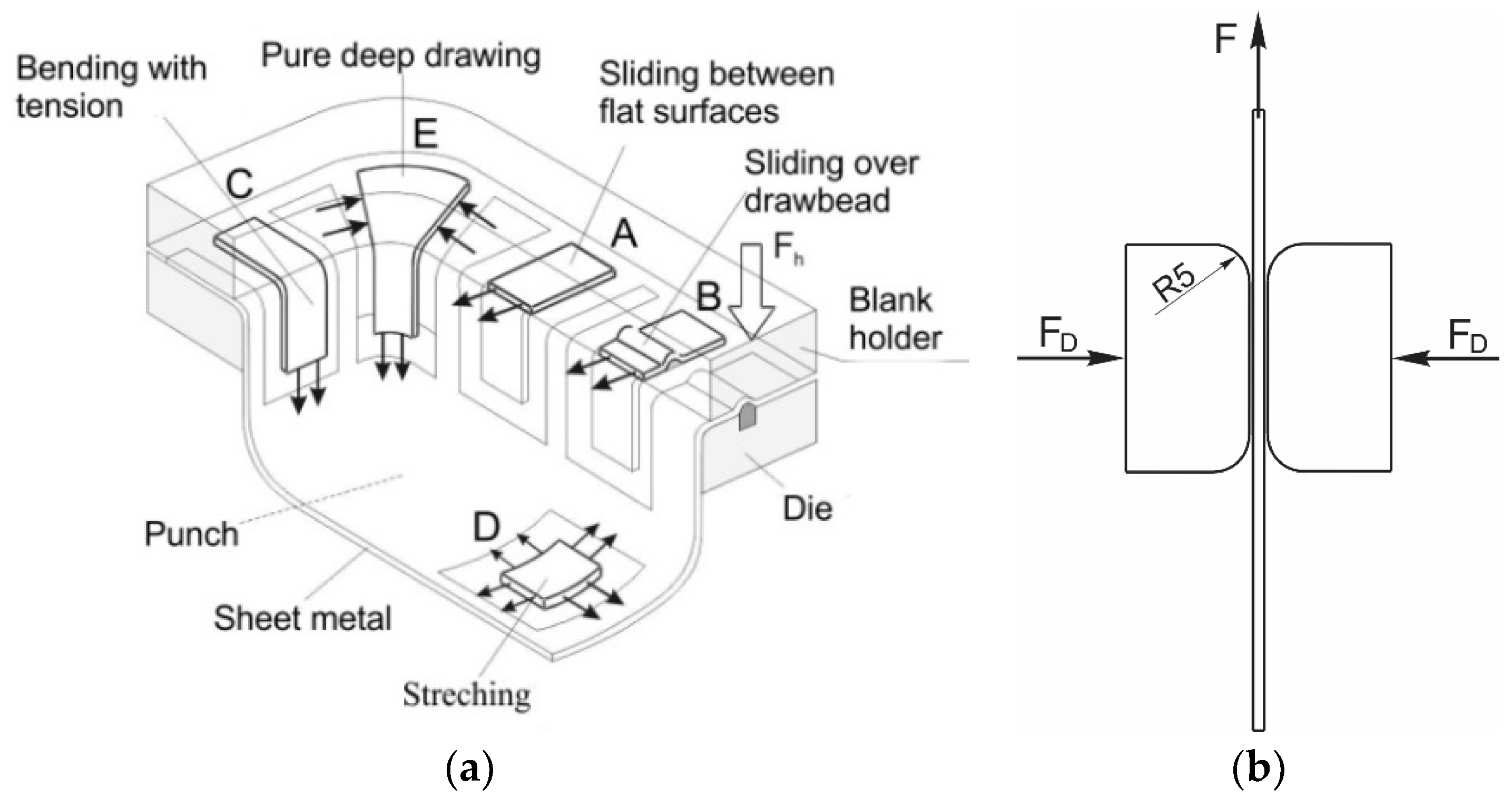
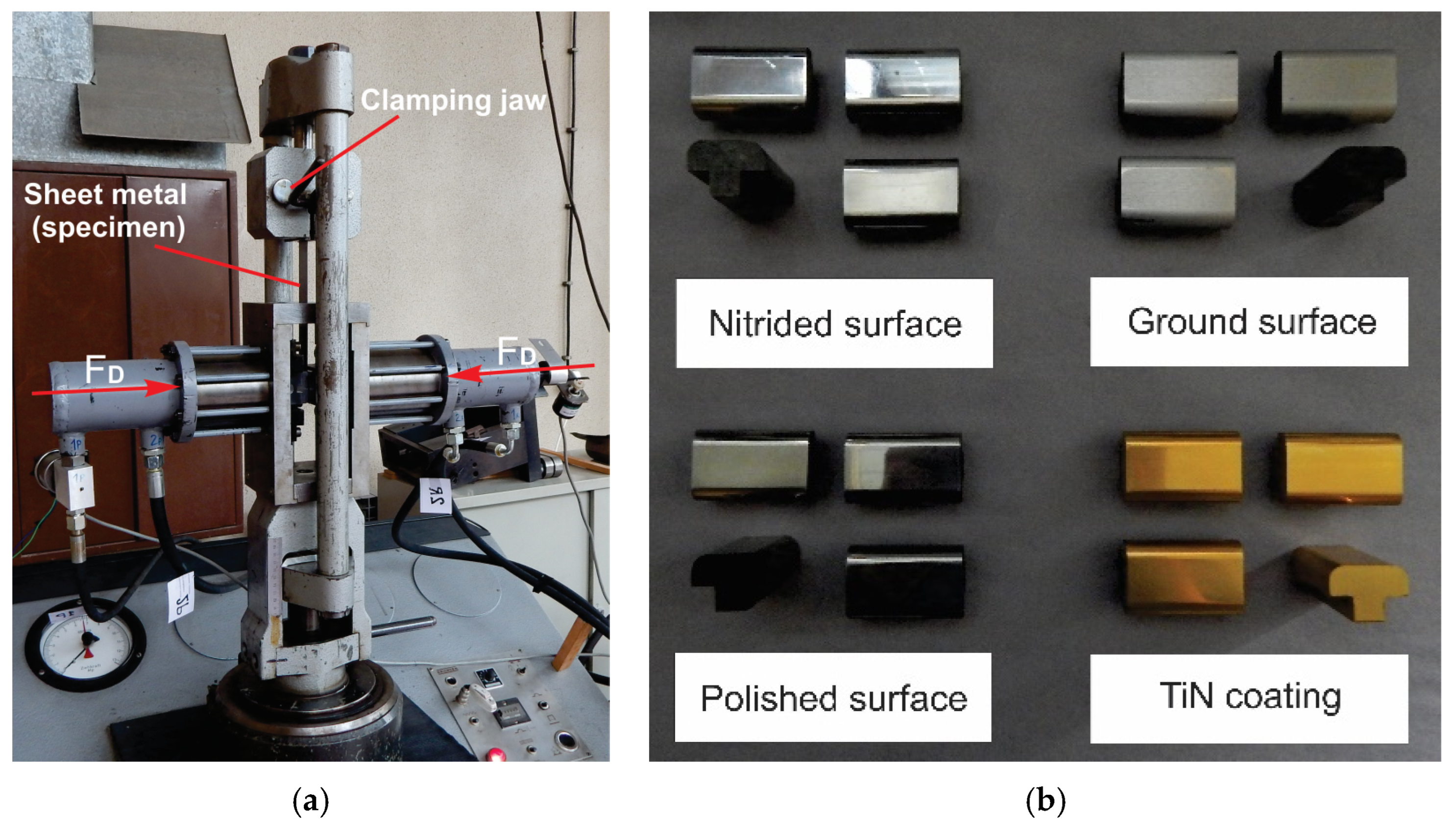
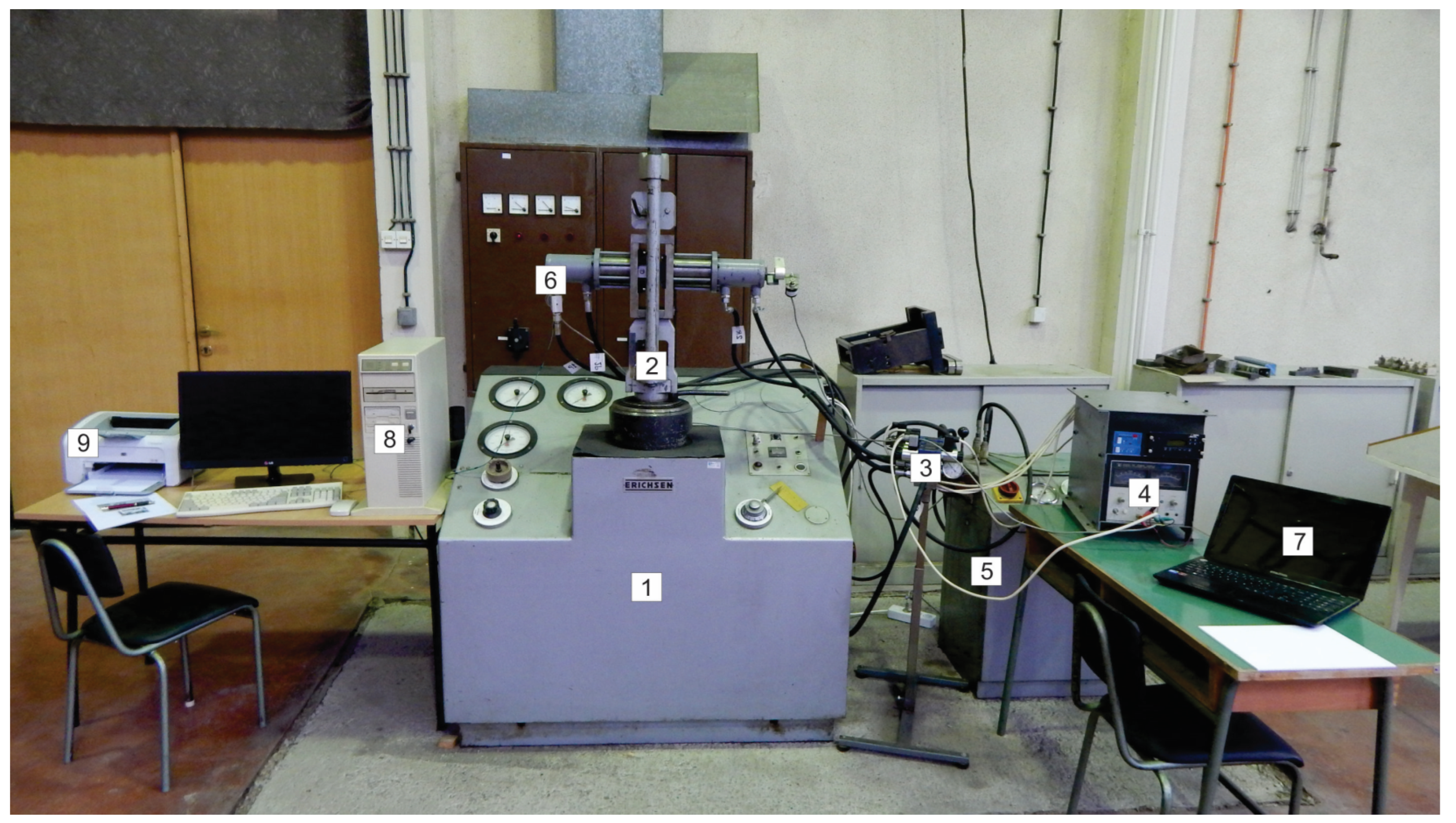
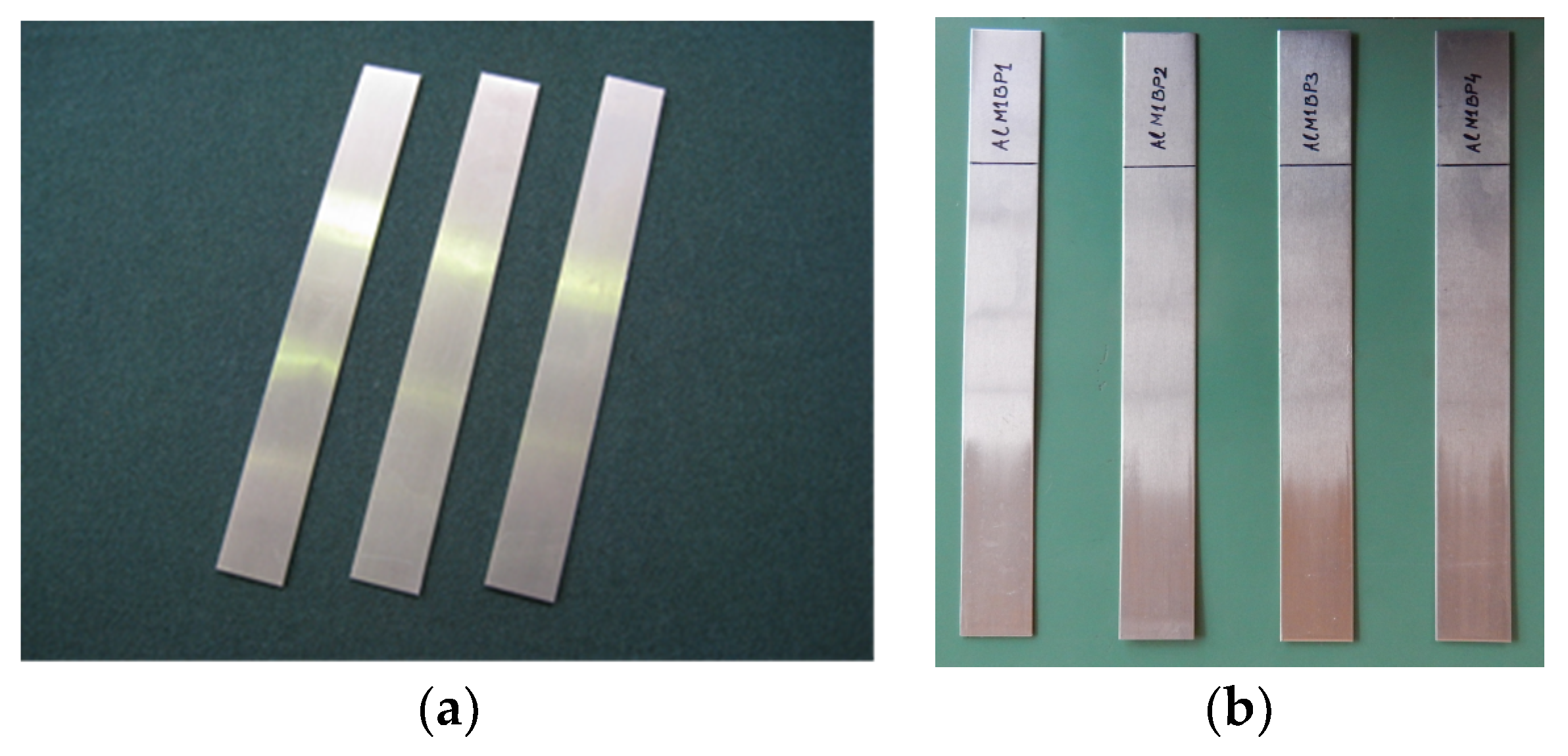
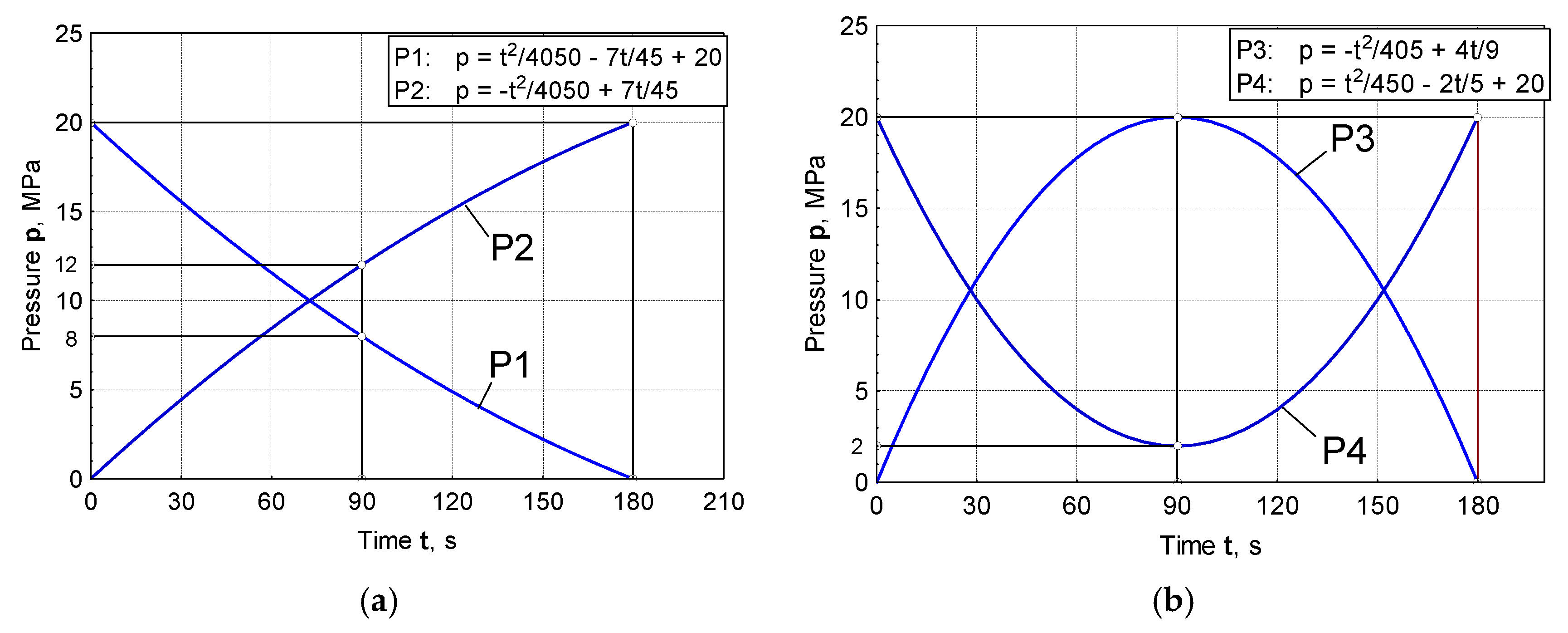
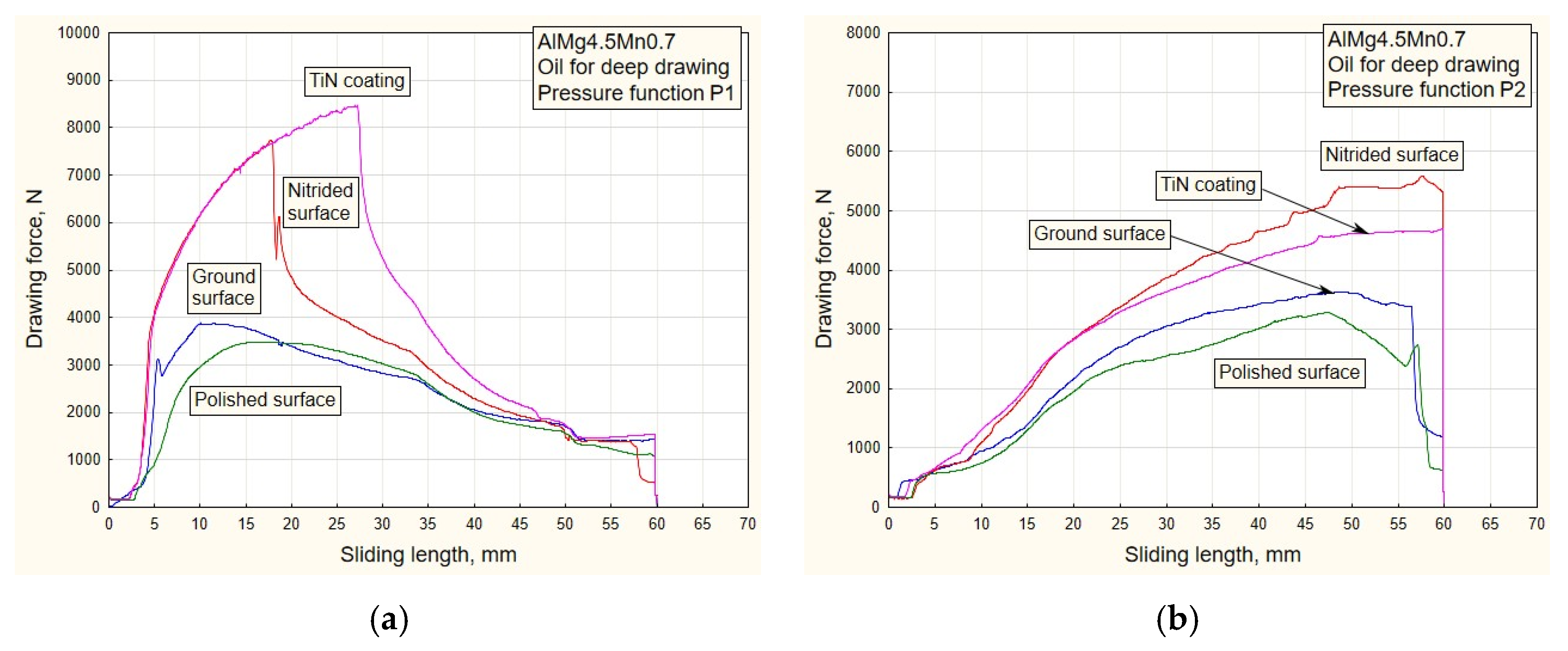
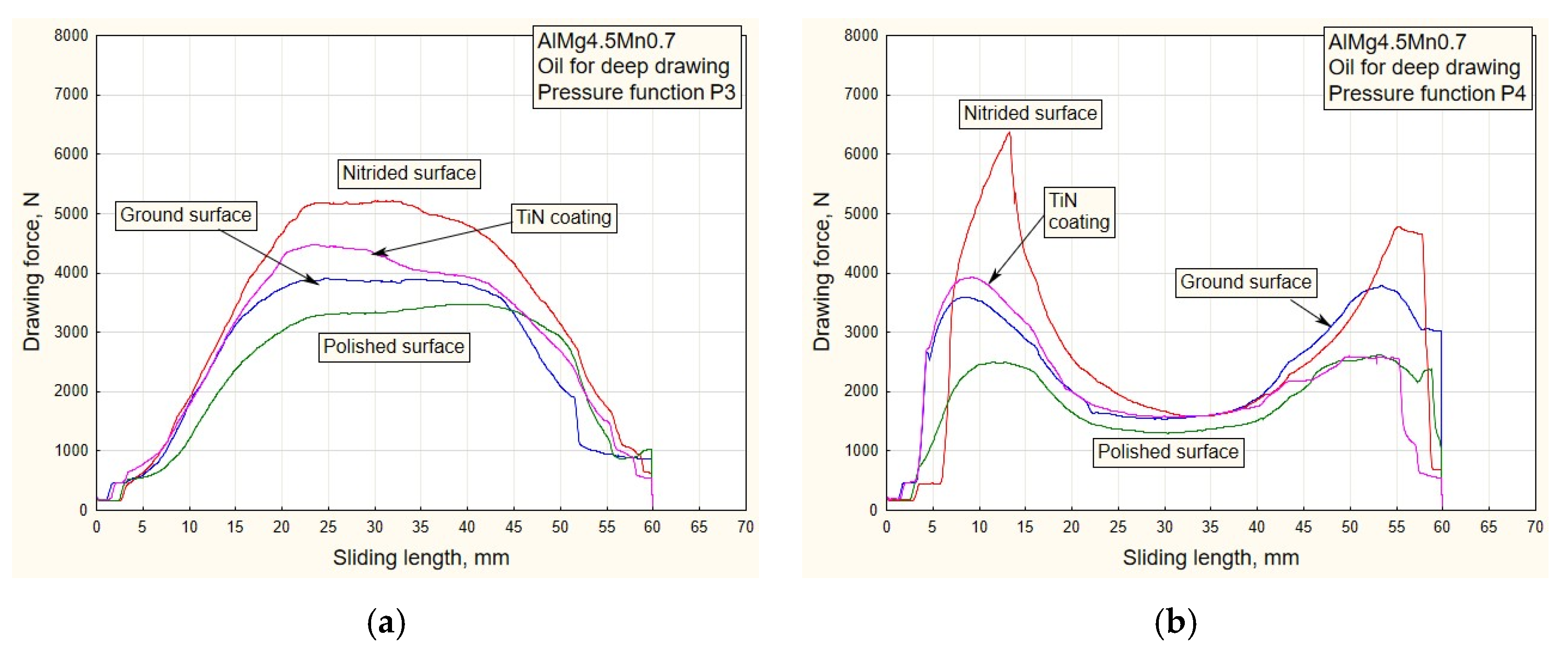
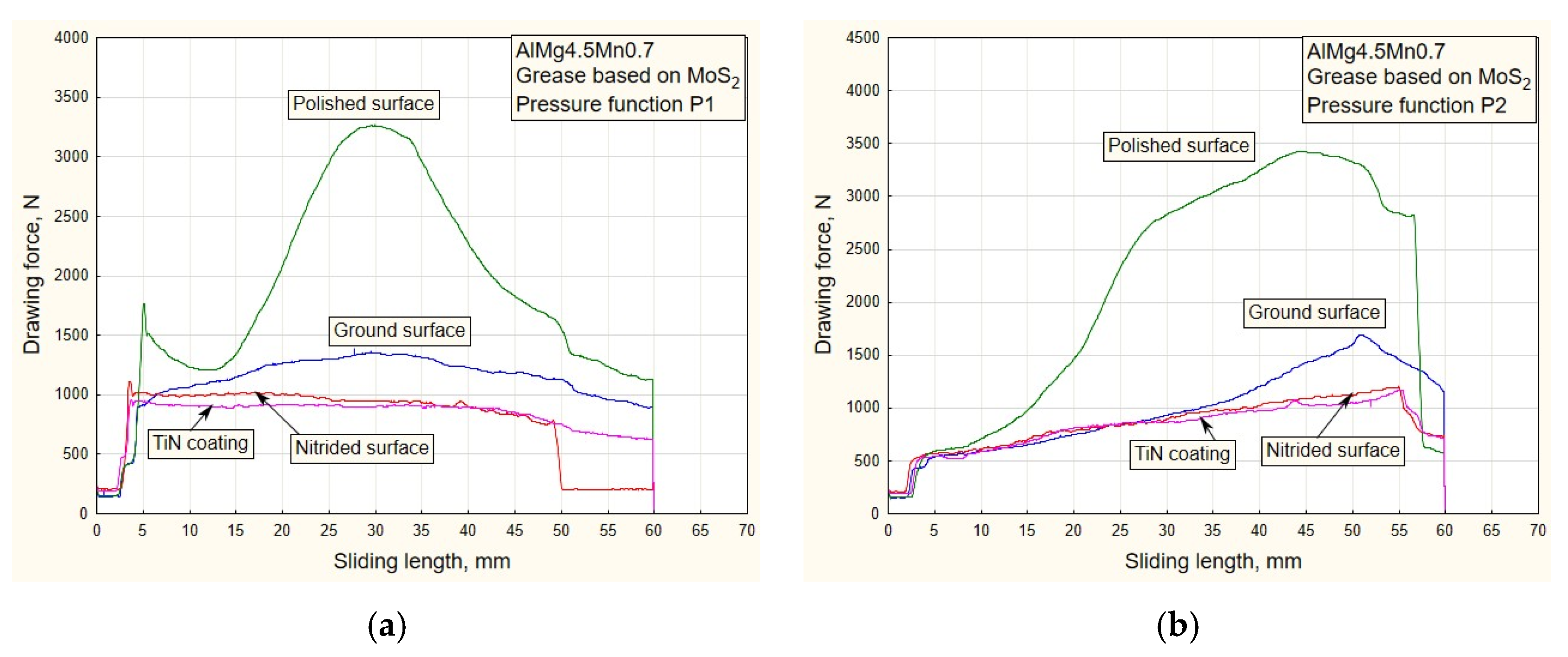

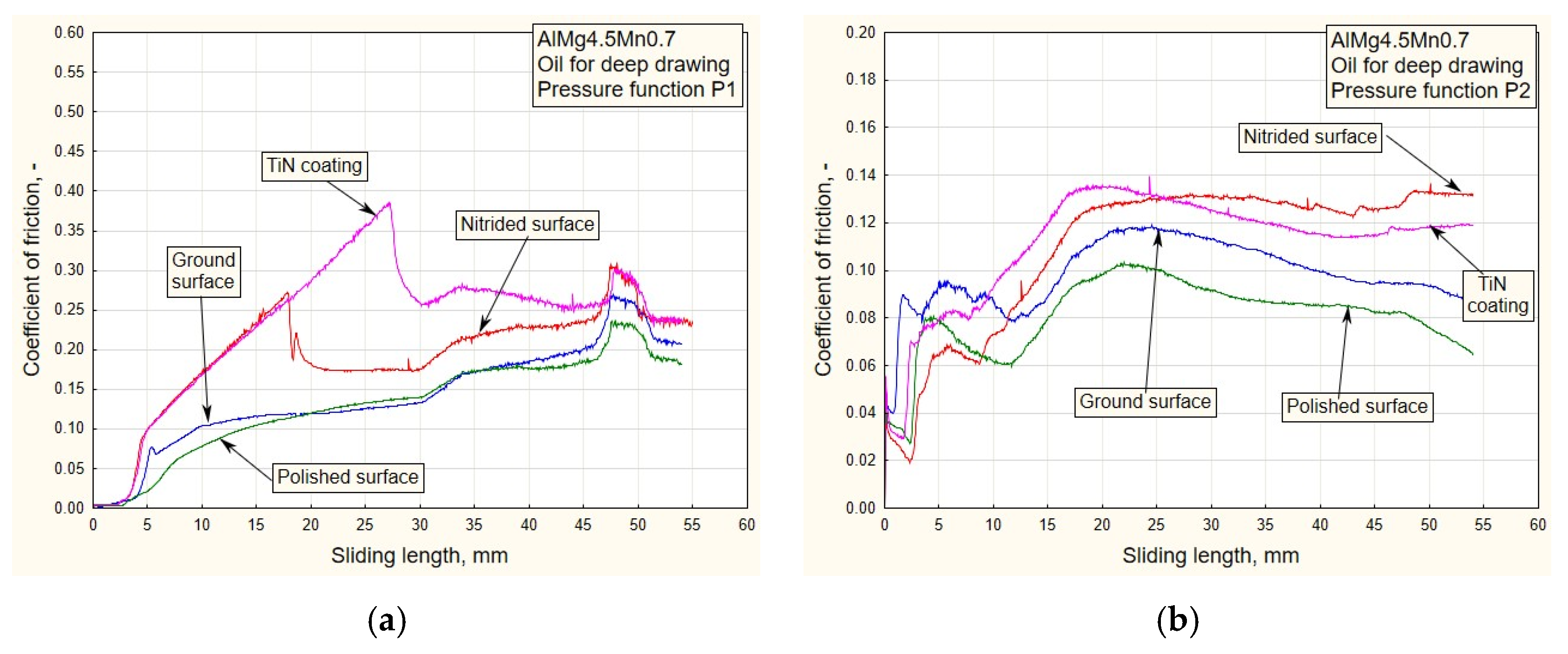
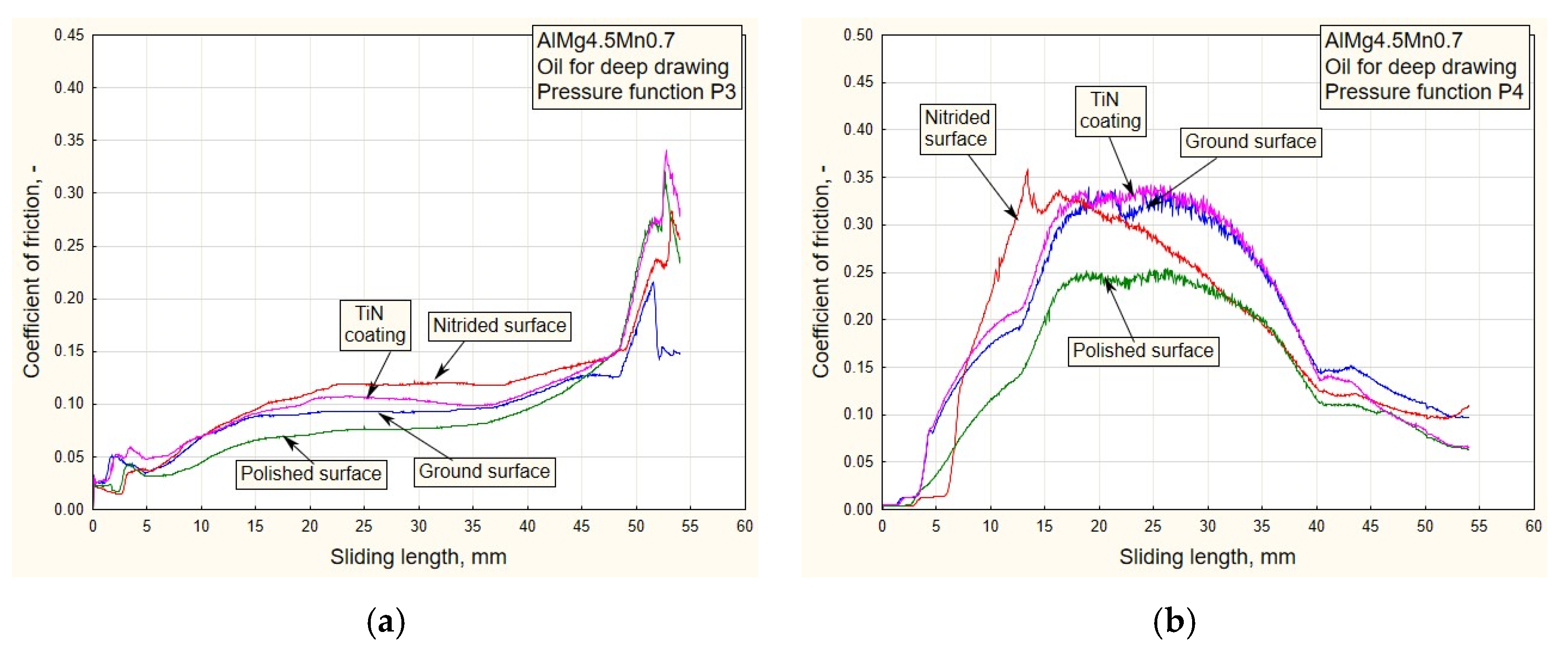
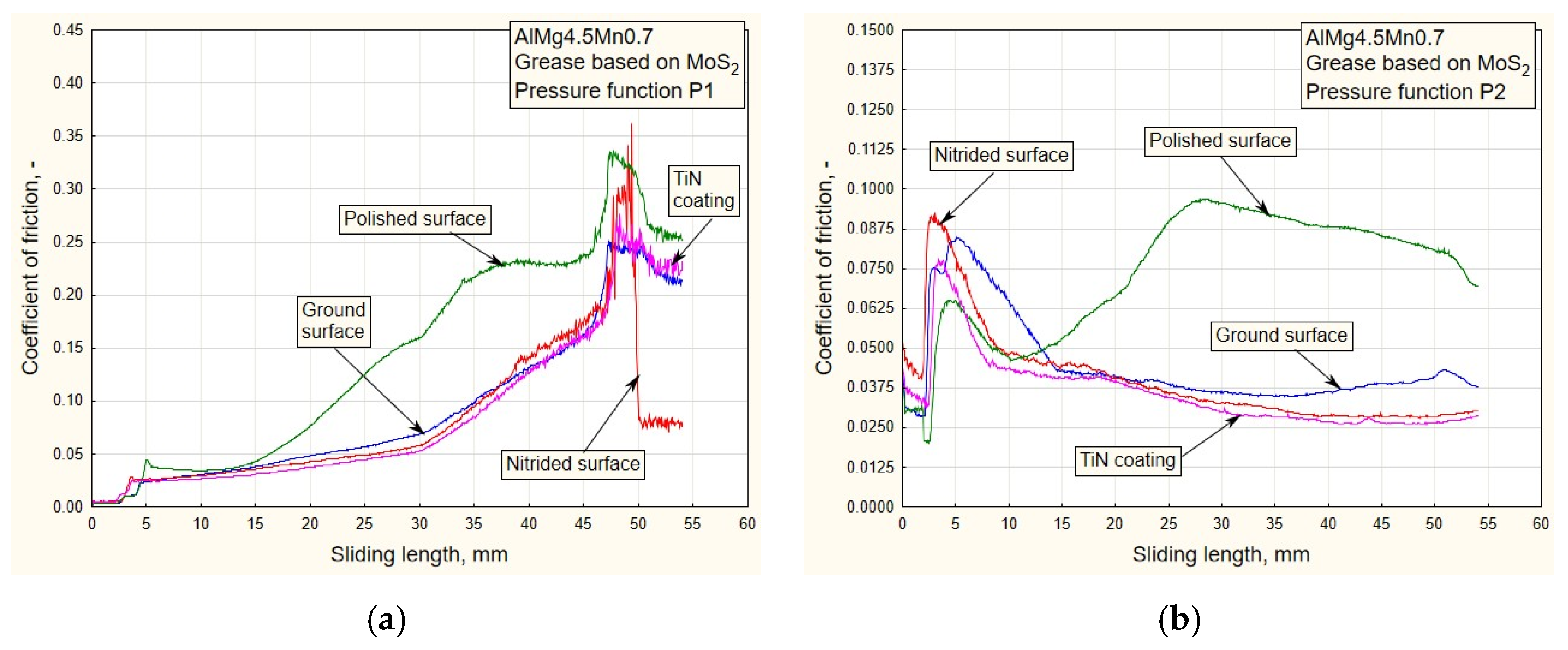
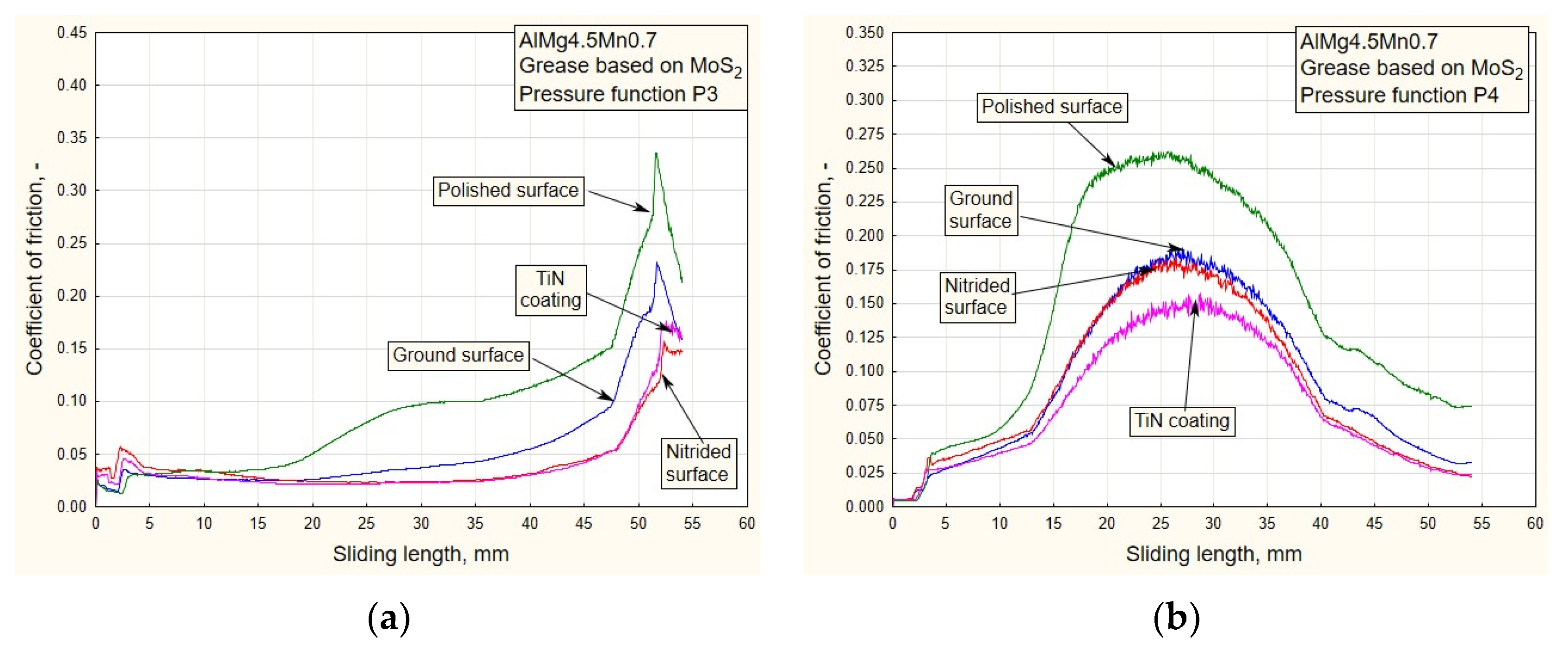
| Type of Surface | Surface Roughness, Ra, μm |
|---|---|
| Nitrided | 0.291 |
| TiN coating | 0.270 |
| Ground | 0.050 |
| Polished | 0.038 |
| Mg | Mn | Si | Fe | Cu | Ti | Zn | Cr | |
|---|---|---|---|---|---|---|---|---|
| % | 4.20 | 0.57 | 0.0869 | 0.29 | 0.013 | 0.007 | 0.068 | 0.092 |
Disclaimer/Publisher’s Note: The statements, opinions and data contained in all publications are solely those of the individual author(s) and contributor(s) and not of MDPI and/or the editor(s). MDPI and/or the editor(s) disclaim responsibility for any injury to people or property resulting from any ideas, methods, instructions or products referred to in the content. |
© 2023 by the authors. Licensee MDPI, Basel, Switzerland. This article is an open access article distributed under the terms and conditions of the Creative Commons Attribution (CC BY) license (https://creativecommons.org/licenses/by/4.0/).
Share and Cite
Djordjević, M.T.; Aleksandrović, S.; Arsić, D.; Nikolić, R.R.; Szmidla, J.; Todić, A.; Čukanović, D.; Ulewicz, R. Influence of TiN Coating on the Drawing Force and Friction Coefficient in the Deep Drawing Process of AlMg4.5Mn0.7 Thin Sheets. Materials 2023, 16, 3968. https://doi.org/10.3390/ma16113968
Djordjević MT, Aleksandrović S, Arsić D, Nikolić RR, Szmidla J, Todić A, Čukanović D, Ulewicz R. Influence of TiN Coating on the Drawing Force and Friction Coefficient in the Deep Drawing Process of AlMg4.5Mn0.7 Thin Sheets. Materials. 2023; 16(11):3968. https://doi.org/10.3390/ma16113968
Chicago/Turabian StyleDjordjević, Milan T., Srbislav Aleksandrović, Dušan Arsić, Ružica R. Nikolić, Janusz Szmidla, Aleksandar Todić, Dragan Čukanović, and Robert Ulewicz. 2023. "Influence of TiN Coating on the Drawing Force and Friction Coefficient in the Deep Drawing Process of AlMg4.5Mn0.7 Thin Sheets" Materials 16, no. 11: 3968. https://doi.org/10.3390/ma16113968
APA StyleDjordjević, M. T., Aleksandrović, S., Arsić, D., Nikolić, R. R., Szmidla, J., Todić, A., Čukanović, D., & Ulewicz, R. (2023). Influence of TiN Coating on the Drawing Force and Friction Coefficient in the Deep Drawing Process of AlMg4.5Mn0.7 Thin Sheets. Materials, 16(11), 3968. https://doi.org/10.3390/ma16113968










